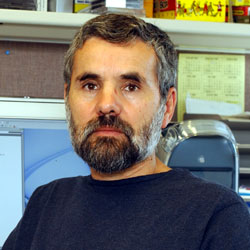| |
| |
| Stanko S. Stojilkovic, Ph.D., Senior Investigator |
 |
Dr. Stojilkovic received a Ph.D. in Physiology and Neuroendocrinology from the University of Novi Sad, Serbia, in 1982. He was Assistant Professor of Physiology at the Institute of Biology, University of Novi Sad, before joining NICHD as a Guest Researcher in 1985, where he worked in the laboratory of Dr. Kevin J. Catt. Dr. Stojilkovic became an Investigator in 1993 and Senior Investigator in 1998, both within the Endocrinology and Reproduction Research Branch of NICHD. His laboratory investigates calcium signaling pathways at the cellular and molecular levels, and determines the manner in which hormones and neurotransmitters utilize calcium as an intracellular messenger in neuroendocrine cells.
|

|
Staff:
- Dr. Karla Kretschmannova, Ph.D., Postdoctoral Fellow, (301) 435-0267 kretschk@mail.nih.gov
- Dr. Shuo Li, Ph.D., Visiting Fellow, (301) 496-7783 lishou@mail.nih.gov
- Dr. Takayo Murano, M.D., Ph.D., Visiting Fellow, (301) 496-6151 muranota@mail.nih.gov
- Dr. Melanija Tomic, Ph.D., Staff Scientist, (301) 496-8164 melatom@mail.nih.gov
- Dr. Zonghe Yan, M.D., Ph.D., Postdoctoral Fellow, (301) 496-7783 yanz@mail.nih.gov
- Dr. Hana W Zemkova, M.D., Visiting Fellow, (301) 496-7783 zemkojan@mail.nih.gov
Research Interests:
Over one hundred neurotransmitters and hormones, acting on their respective receptors and receptor-channels, relay their signals by altering intracellular calcium concentration. For the generation of calcium signals, cells depend on the large electrochemical gradient of calcium across the plasma membrane, or across the endoplasmic reticulum membrane. There are several pathways controlling calcium influx, including ligand-gated receptor-channels and voltage-gated calcium channels. Calcium release from endoplasmic reticulum is activated by G protein-coupled and tyrosine kinase receptors, and is mediated through inositol (1,4,5)-trisphosphate)-sensitive receptor-channels. Many excitable cells also express ryanodine-sensitive calcium release channels in their endoplasmic/sarcoplasmic reticulum, and these are coupled to voltage-gated calcium channels by a mechanism termed calcium-induced calcium release.
The main objectives of current investigations in the Section on Cellular Signaling are to clarify the mechanisms that control calcium signaling and to elucidate the role of calcium ions as intracellular messenger in neuroendocrine and endocrine cells. The approach in the laboratory has been to characterize calcium signaling in these cells from biophysical, physiological, and pharmacological points of view. More recently, we have begun to use molecular biological approaches to identify molecules participating in the generation and control of calcium signals, as well as to address the issues of how the calcium signaling function in these cells is related to the structure of individual receptors and channels. Current research includes studies on the receptor- and intracellular messenger-mediated control of voltage-gated calcium influx; the structure and function of purinergic receptor-channels; cyclic nucleotide-controlled membrane excitability and calcium signaling; the role of calcium in controlling plasma membrane and endoplasmic reticulum excitability; the dependence of cyclic nucleotide production on calcium; and the relevance of the pattern of calcium signaling to cell-type specific hormone secretion patterns.
|
Selected Recent Publications:
Gonzalez-Iglesias AE, Jiang Y, Tomic M, Kretschmannova K, Andric SA, Zemkova H, Stojilkovic SS. (2006) Dependence of electrical activity and calcium influx-controlled prolactin release on adenylyl cyclase signaling pathway in pituitary lactotrophs., Mol Endocrinol 20, 2231-46.
Full Text/Abstract
Zemkova H, Balik A, Jiang Y, Kretschmannova K, Stojilkovic SS. (2006) Roles of purinergic P2X receptors as pacemaking channels and modulators of calcium-mobilizing pathway in pituitary gonadotrophs., Mol Endocrinol 20, 1423-36.
Full Text/Abstract
Yan Z, Liang Z, Obsil T, Stojilkovic SS. (2006) Participation of the Lys313-Ile333 sequence of the purinergic P2X4 receptor in agonist binding and transduction of signals to the channel gate., J Biol Chem 281, 32649-59.
Full Text/Abstract
Yan Z, Liang Z, Tomic M, Obsil T, Stojilkovic SS. (2005) Molecular determinants of the agonist binding domain of a P2X receptor channel., Mol Pharmacol 67, 1078-88.
Full Text/Abstract
Andric SA, Zivadinovic D, Gonzalez-Iglesias AE, Lachowicz A, Tomic M, Stojilkovic SS. (2005) Endothelin-induced, long lasting, and Ca2+ influx-independent blockade of intrinsic secretion in pituitary cells by Gz subunits., J Biol Chem 280, 26896-903.
Full Text/Abstract
Stojilkovic SS, Zemkova H, Van Goor F. (2005) Biophysical basis of pituitary cell type-specific Ca2+ signaling-secretion coupling., Trends Endocrinol Metab 16, 152-9.
Full Text/Abstract
Zemkova H, He ML, Koshimizu TA, Stojilkovic SS (2004) Identification of ectodomain regions contributing to gating, deactivation, and resensitization of purinergic P2X receptors, J Neurosci 24, 6968-6978.
Full Text/Abstract
All Selected Publications
Contact Information:
Dr. Stanko S. Stojilkovic
Cellular Signalling Section
Endocrinology and Reproduction Research Branch, NICHD
Building 49, Room 6A36
49 Convent Drive MSC 4510
Bethesda, MD 20892-4510
Telephone: (301) 496-1638 (office),
(301) 594-7031 (fax)
Email: stankos@helix.nih.gov
|
|















